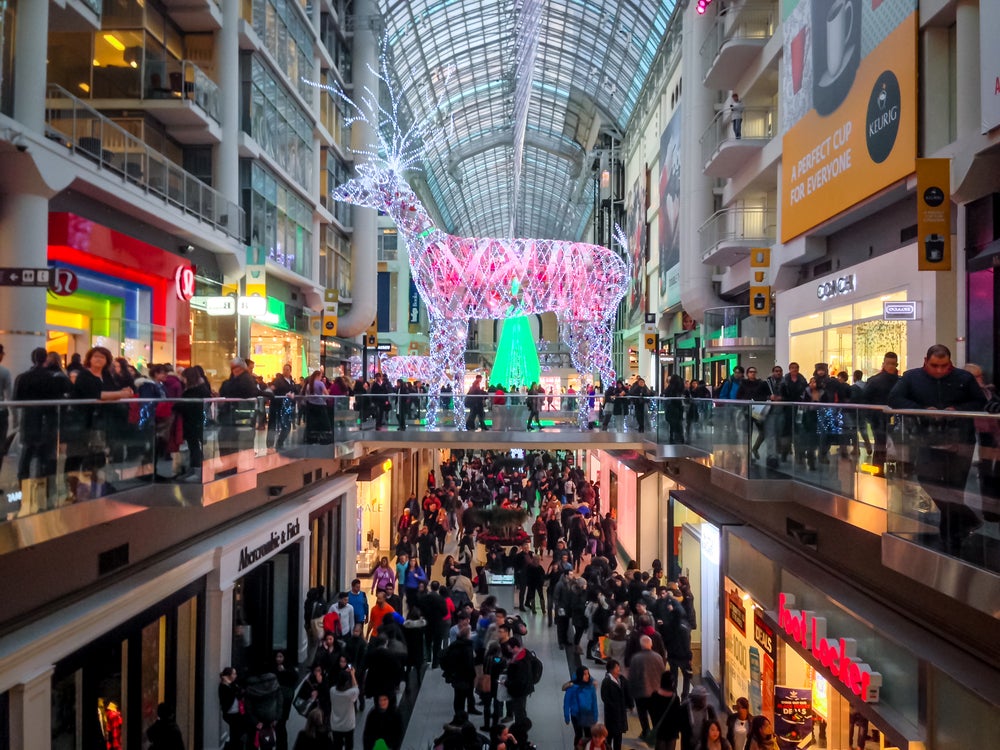
Tomorrow marks Thanksgiving in the United States, but savvy shoppers will already have their eyes on Friday as retailers prepare for one of the busiest shopping days of the year.
Kicking off the Christmas shopping season, retailers slash more than 40% off of their products on average to entice shoppers into their stores. With spending in the US having reached more than $8bn last year according to Adobe, customers are seemingly more than happy to oblige.
But where did Black Friday come from, and how has it grown over the years?
Why is it called Black Friday?
There is no definite explanation for the name. However, the first Friday after Thanksgiving has been referred to as Black Friday in the United States since the 1960s, long before the day became the busiest shopping day of the year.
The name could be a reference to old bookkeeping practices, in which profits would be written in black ink and losses would be written in red ink. Explanations suggest that the first Friday after Thanksgiving, which marks the start of the Christmas shopping period, is one of the first days of the year that retailers turn a profit.
However, ‘black’ days are often a reference to tragic or disastrous events. The start of the Great Depression is known as Black Tuesday, for example. Likewise, before Black Friday as we know it, the same name was associated with a 19th century financial crash, in which two Wall Street financers caused the gold market to collapse.
How well do you really know your competitors?
Access the most comprehensive Company Profiles on the market, powered by GlobalData. Save hours of research. Gain competitive edge.

Thank you!
Your download email will arrive shortly
Not ready to buy yet? Download a free sample
We are confident about the unique quality of our Company Profiles. However, we want you to make the most beneficial decision for your business, so we offer a free sample that you can download by submitting the below form
By GlobalDataAccording to Oxford English Dictionary, the name is more likely a reference to an increase in traffic on the roads as people head out to shop.
It seems the original thought behind the name has been lost for some time. In 1984, the Phildelphia Inquirer reported:
“How the day got its name is a matter of debate. Shoppers contend that it is derived from the enormous crowds that make shopping somewhat unpleasant. But merchants say it has to do with the fact that the level of sales before Christmas can mean the difference between losses for the year – or red in on a retailer’s ledge – and profits – or black ink.”
The term is thought to have been coined by police officers in Philadelphia, Pennsylvania, before spreading across the US.
A history of Black Friday
| Macy’s Thanksgiving Parade The debut Macy’s Thanksgiving Day Parade was held in 1924, which would later come to be associated with the start of the Christmas shopping season. |
||
| Army-Navy Game Philadelphia frequently hosted the Army-Navy Game, causing an influx in tourists that is thought to have led police officers to coin the Black Friday name in the 1960s. |
||
| Early opening In order to make the most of Black Friday’s increase in customers, stores began opening in the early hours of the morning in the 1990s. |
||
| Financial crash 2008 marked the only year since the early 2000s that Black Friday spending fell. Likely a result of the financial crisis, spending fell by 4.6% from 2007 to 2008. |
||
| Going global Black Friday didn’t take off outside of North America until the current decade, with online retailer Amazon often credited with bringing it to the UK. |
When did Black Friday begin?
The day itself was born out of the Thanksgiving Day parades held by major department stores such as Macy’s which has ran every year in New York since 1924, which are essentially used by these retailers as an advertising push. These parades, held on Thanksgiving, mark the start of the Christmas shopping season and cause an influx of shoppers immediately after.
That influx would be even worse in Philadelphia, a frequent host of the Army-Navy Game, an American football match between college students from the US Naval Academy and the US Military Academy, which takes place around that time of year. Tourists would begin flooding into the city following Thanksgiving’s conclusion ahead of the game, with many heading to the shops to get a head start on the Christmas sales.
According to History, department stores in the city tried to brand the day as “Big Friday”, but were unable to shake the Black Friday name. It is thought that the story of black indicating profit was thought up by retailers after this in an attempt to shake the negatives associated with the day.
When did Black Friday take off?
It took some time for Black Friday to spread. In a 1985 issue of the Philadelphia Inquirer, department stores in major US cities, such as Los Angeles and Cincinnati, stated that they had “no idea what it means”.
It wasn’t until the 1990s that Black Friday really took off, as retailers began opening stores early in order to maximise their earnings. Shoppers began camping outside stores to score the best deals when stores opened and, to appease the crowds, opening times were pushed further forward. In 2011, Wal-Mart, Best Buy, Macy’s, Kohl’s and Target all announced that they would open their doors at midnight for the first time.
By the early 2000s, shoppers in the US were spending more than $400bn during the holiday season, and spending has grown in all but one year since, according to data published by the National Retail Federation.
Retailers are continuing to encourage shoppers to spend in the period after Thanksgiving, with many stores now pushing deals over a five-day period, starting on Thanksgiving and running until the Monday after, which is now known as Cyber Monday.
Black Friday spending: Year by year
US spending throughout the holiday season stood at $682bn in 2017, with the average person spending close to $1,000. According to software company Adobe Analytics, some $8bn of that total was spent on Black Friday alone.
Annual holiday season spending in the United States
When did Black Friday go global?
Black Friday didn’t start to make its way outside of North America until the current decade.
The shopping day arrived in the UK in 2010, thought to have been brought over by major online retailer Amazon, which ran a series of ‘lightning’ sales throughout the week.
Stores such as electronics retailer Pixmania and DIY chain B&Q also offered discounts, while Oxford Street and Regent Street, two of London’s busiest roads, were closed due to an increase in foot traffic as retailers began slashing their prices.
According to mail service provider Citipost, Black Friday has grown in popularity across Europe and Australia over the past decade, as well as parts of Asia, Africa and South America.
Read more: Black Friday predictions: What trends are expected to take place






